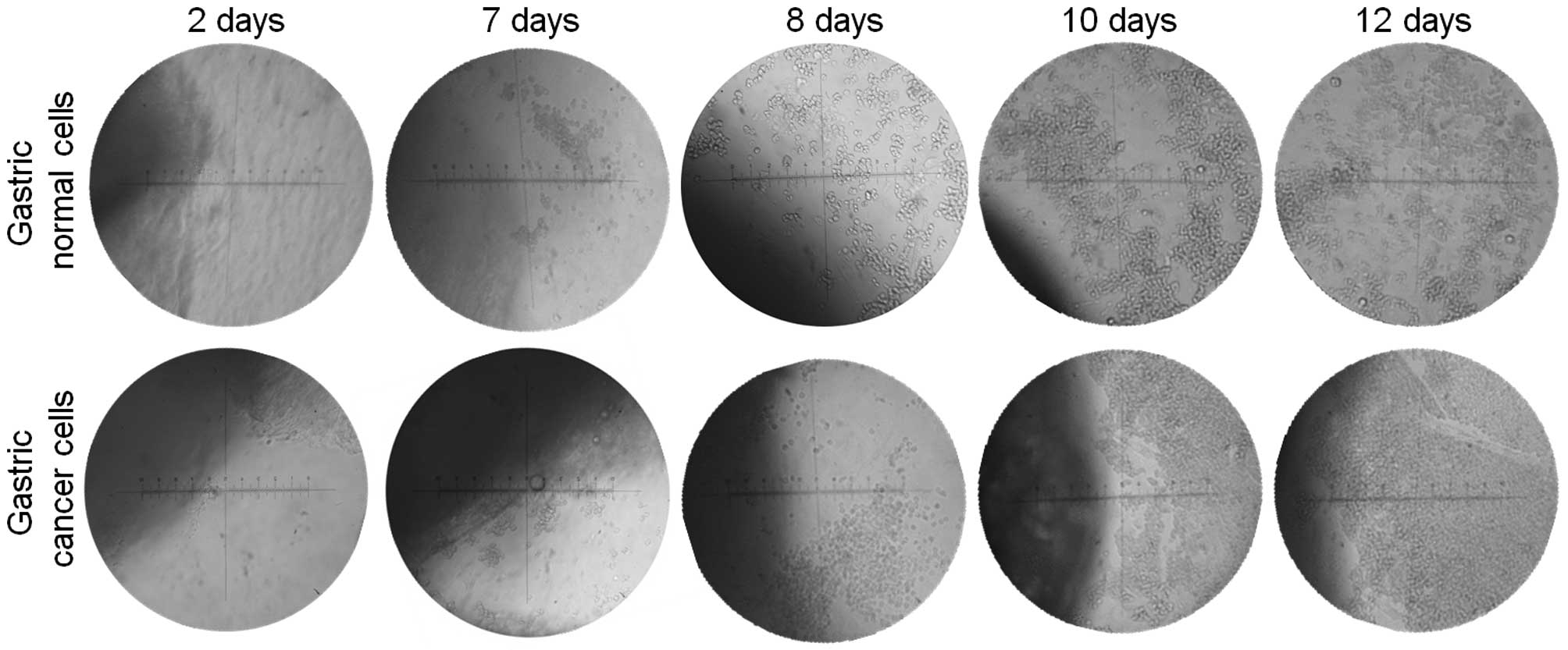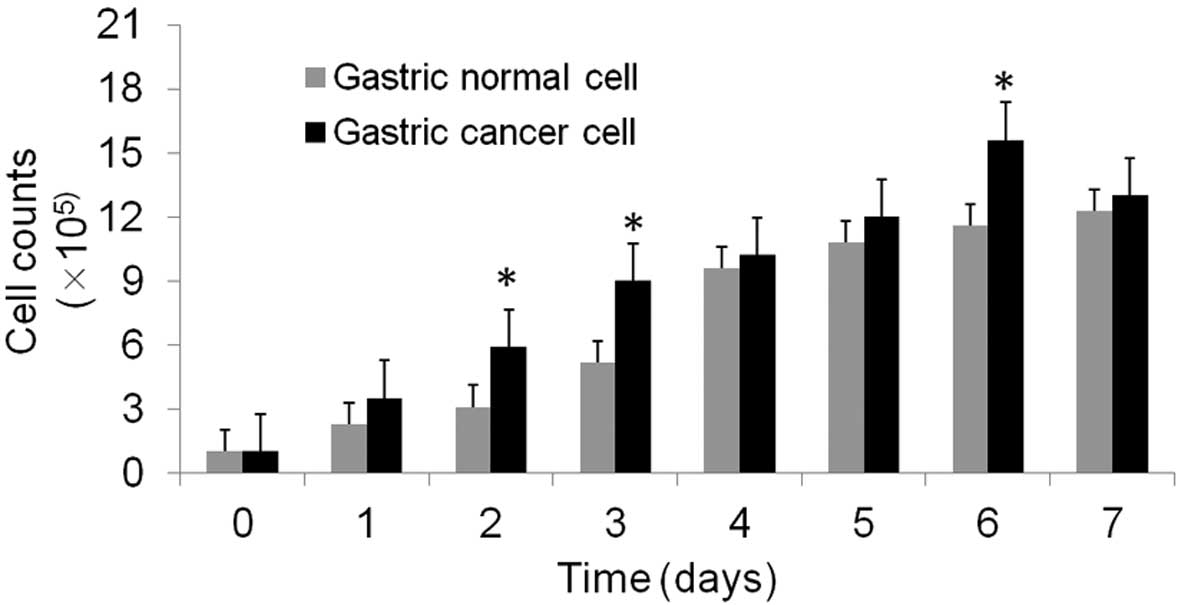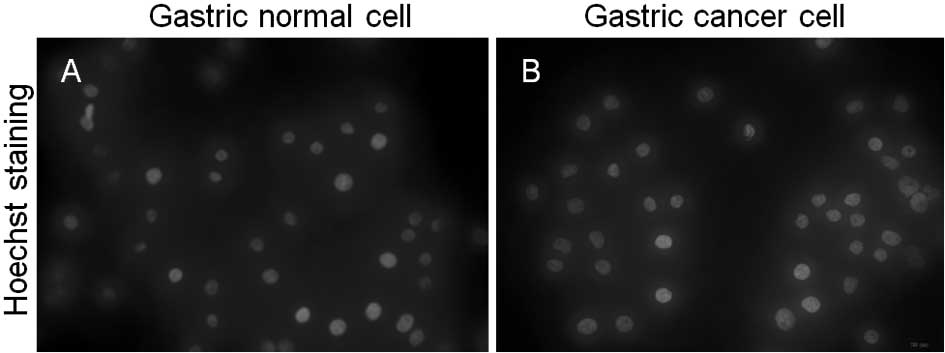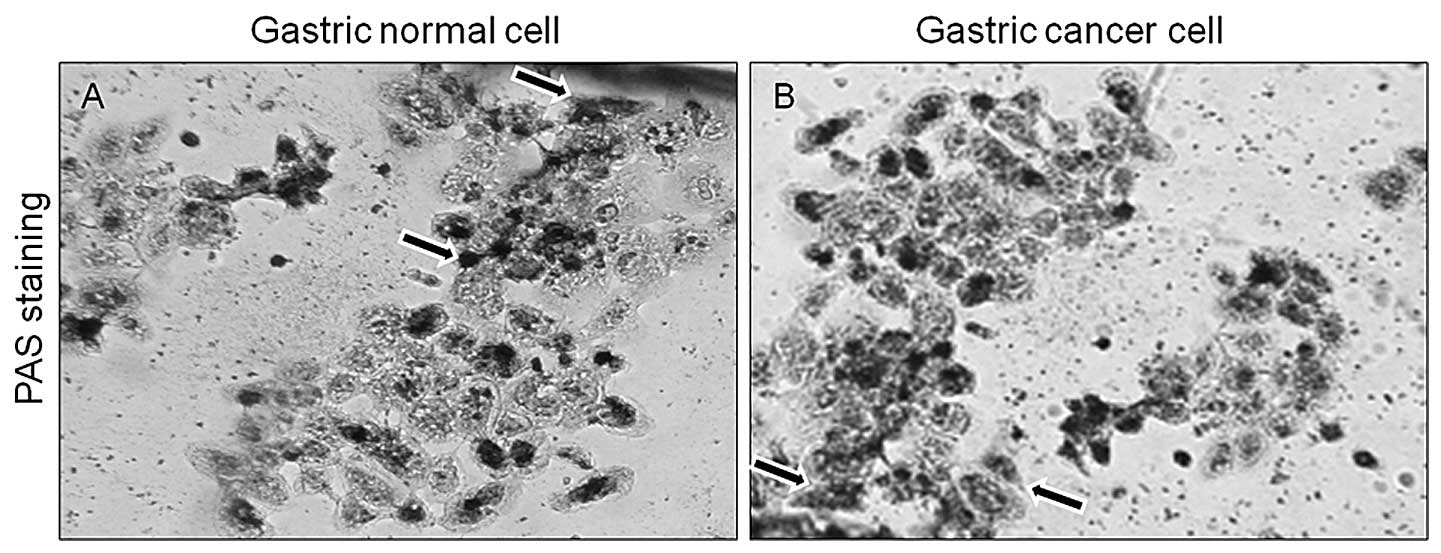A method for establishing human primary gastric epithelial cell culture from fresh surgical gastric tissues
- Authors:
- Published online on: April 28, 2015 https://doi.org/10.3892/mmr.2015.3692
- Pages: 2939-2944
Abstract
Introduction
Helicobacter pylori (H. pylori) is a gram-negative, microaerophillic, flagellated bacteria, which affects >50% of the world’s population (1–3). Gastric cancer is a leading malignant disease in numerous countries, including China, Korea and Japan (4). H. pylori is ranked as a class I carcinogen by the International Agency for Research on Cancer (Lyon, France). H. pylori colonizes to the gastric mucosa and adheres to gastric epithelial cells; therefore, it is of interest to use human cells in the study of H. pylori infection (5). However, the availability of human gastric normal and cancer cell lines is limited and it is difficult to successfully culture gastric epithelial cells (5,6).
Gastric biopsy tissues are widely used in gastric cancer research, but have various drawbacks (7). A significant limitation of using tissues from endoscopic biopsies is the lack of sufficient cell numbers for plating. For the successful growth and differentiation of epithelial cells a certain cell planting density and the use of the appropriate culture media is required (8). Gastric cell lines established from human gastric surgical tissues may prove more useful in the study of gastric infectious diseases (4). At present, gastric epithelial biology research relies on primary cultures generated from fresh surgical tissues (6). There are numerous advantages to this technique, including the maintenance of characteristics of the original tissue and low interference of stromal components. Surgical tissues are therefore suitable for use in the study of cell morphology, genetic characteristics, cell differentiation, invasion, metastasis and gastric cancer therapy (7).
Several methods have been reported for the isolation of cells from the gastric mucosa for cell culture (8). However, the successful isolation and subsequent culture of human gastric mucous epithelial cells has remained difficult due to numerous factors (8). The production of various gastric stromal factors, including fibroblasts, interferes with the analysis of gastric cancer cells. Furthermore, too great a number of passages of the cells altered the protein expression and mutation behavior of the cultured cells compared to those in vivo (7,8).
Therefore, the establishment of human gastric cell lines exhibiting a true epithelial phenotype is an important step in the study of gastric epithelial cells (9). The present study therefore aimed to develop a continuous human gastric epithelial cell culture from gastric surgical tissue, which may be used in the study of H. pylori gastric infections.
Materials and methods
Cell culture reagents and media
RPMI-1640, fetal bovine serum (FBS), trypsin/EDTA and penicillin/streptomycin were purchased from Invitrogen Life Technologies (Carlsbad, CA, USA). Polyclonal rabbit anti-H. pylori was purchased from Dako North America, Inc. (Carpinteria, CA, USA). Mouse anti-carbohydrate antigen 724 (CA724), amphotericin B, fibronectin and horseradish peroxidase (HRP)-conjugated anti-rabbit and anti-mouse immunoglobulin G were purchased from Santa Cruz Biotechnology Inc. (Dallas, TX, USA). Rabbit anti-proliferating cell nuclear antigen (PCNA), cytokeratin 18 and granulin (GRN) were purchased from ProteinTech Group, Inc. (Chicago, IL, USA). Cytokeratin 19 was purchased from ZSGB-BIO (Beijing, China). Tissue culture plates and flasks were purchased from Corning-Costar (Corning, New York, NY, USA). Hoechst 3358 was obtained from Beyotime Institute of Biotechnology (Haimen, China) and periodic acid was purchased from Sinopharm Group Co., Ltd (Beijing, China).
Preparation of fibronectin-coated flask
Fibronectin was dissolved in cell culture medium at a concentration of 100 μg/ml. Subsequently, sufficient fibronectin solution (3 ml) to provide a coating was added to a cell-culture flask and cell-culture plate and incubated at 37°C for 1–2 h. The fibronectin solution was aspirated and rinsed with media, prior to storage at 4°C.
Preparation of media
RPMI-1640 media was supplemented with 20% FBS, 100 U/ml penicillin, 100 μg/ml streptomycin, 25 mM hepes buffer (Tocris Bioscience, Bristol, UK), 20 mM sodium bicarbonate (Tianjin KaiXin chemical industry, Tianjin, china) and 0.5 U/ml insulin (Sigma-Aldrich, St. Louis, MO, USA). The transport medium did not contain serum and was supplemented with 2 μg/ml amphotericin B (Sigma-Aldrich).
Human gastric surgical tissue procurement
Gastric tissues (n=45) were obtained from patients (age, 35–85) undergoing surgical gastrectomy. Gastric cancer tissues were obtained at the Dalian Medical First and Second Affiliated Hospitals (Dailan, China) between 2012 and 2013. Surgical tissues were removed from the tumor sections, adjacent tissue and normal gastric mucosa of 45 different patients. The specimens were collected in transport medium and transported to the research laboratory. All gastric tissue samples collected from the patients and the research protocols were performed in accordance with the Institutional Review Board of Dalian Medical University (Dailan, China).
Tissue processing and plating
Gastric tissues were placed in 100-mm cell culture plates containing transport media and the fat, connective and necrotic sections of the tissue were removed. The remaining tissue was finely cut into 1-mm3 sections. For the primary tumor culture, invasive areas were selected from the serosal surface, whenever possible, to decrease the chance of microbial contamination. Normal and cancerous tissue sections from each patient were arranged in fibronectin-coated culture flasks (n=45), with 0.5-cm spacing between each tissue and incubated at 37°C with 5% CO2. Initially, no media was added so that the tissue edges dried and adhered to the surface. Following three hours of incubation without media, when the edges of the tissue were sufficiently dry, the tissue was supplemented with sufficient trace medium (1–2 ml) to cover the bottom of the flask. The media was replaced every 24 h. Prior to replacing the media, the flask was stood vertically and following the change of media, the flask was carefully laid down in order to avoid the detachment of tissue pieces. Following six times of culture, tissues which had epidermal cells that were identifiable under a microscope were marked. Unmarked tissues were removed by curettage when replacing the culture medium. Any remaining fibroblasts were also scratched off, which resulted in a significant reduction in the number of fibroblast cells in the culture. Epithelial cells were confirmed by cytokeratin 18 and 19 antigen expression and gastric cancer cells were identified using GRN and CA724 markers. Cell proliferation was determined by immunocyto-chemical analysis of PCNA expression.
Gastric cell growth rate
A suspension of l×l05 cells was seeded in 35-mm plastic dishes in the culture medium. The number of cells was counted in triplicate at 24-h intervals for seven days using a hemocytometer (Sysmex, Kobe, Japan). The doubling times of the cell populations were estimated during the exponential growth phase.
Periodic acid-Schiff (PAS) staining
Cells were trypsinized and seeded onto cover slips. The sections were rinsed in phosphate-buffered saline (PBS), oxidized for 5 min in 0.5% periodic acid (Sinopharm Group Co., Ltd), rinsed once in PBS prior to the addition of Schiff’s reagent (Sigma-Alrich) for 15 min. The Schiff’s reagent was subsequently removed and the sections were rinsed with tap water for 10 min. Finally, the sections were counterstained with hematoxylin (Santa Cruz Biotechnology, Inc.) and cover-slips were mounted with mounting media for microscopic visualization (Olympus IX71; Olympus Corp., Tokyo, Japan).
Immunocytochemistry
Cells, which had been continuously passaged until they were pure epithelial cells, were grown on glass coverslips, fixed with 4% paraformaldehyde (Sigma-Aldrich) for 20 min and subsequently treated with 0.1% Triton-PBS (Merck, Darmstadt, Germany) for 10 min. Following being blocked with goat serum (Santa Cruz Biotechnology, Inc.) for 2 h, cells were incubated with polyclonal rabbit anti-H. pylori (1:100), rabbit anti-cytokeratin 18 (1:100), rabbit anti-cytokeratin 19 (1:100), rabbit anti-PCNA (1:100), rabbit anti-GRN (1:100) or mouse anti-CA724 (1:100), at 4°C overnight. The next day, the sections were rinsed with PBS and subsequently incubated with their respective secondary antibody (HRP-conjugated anti-rabbit and anti-mouse IgG for 30 min at room temperature. Immunocytochemical staining was performed using an avidin-biotin peroxidase complex kit (ZSGB-BIO, Beijing, China). Samples were then mounted with mounting medium containing DAPI (Santa Cruz Biotechnology, Inc. Images were captured with an inverted microscope (Olympus IX71; Olympus Corp., Tokyo, Japan).
Determination of mycoplasmic contamination using the Hoechst method
Cells were trypsinized, seeded on cover slips and fixed in 4% paraformaldehyde for 15 min, prior to the addition of 100% cold methanol for 20 min at room temperature. Cells were subsequently rinsed three times with PBS and stained with Hoechst (5 μg/ml) for 15 min at room temperature. Finally, cells were rinsed with PBS and visualized under a fluorescence microscope (Olympus IX71; Olympus Corp.).
Statistical analysis
Statistical differences between test groups were analyzed using independent and paired Student’s t-test and GraphPad Prism 5.03 software was used to statistical analyses (GraphPad Software, Inc., La Jolla, CA, USA). P<0.05 was considered to indicate as statistically significant difference between values.
Results
Gastric primary cell culture
Following seven days of culture of the explants of gastric tissue, epithelial cells began their outward migration of growth from the explants and started to increase their cell number with time. The cells reached high numbers at days 10–12 of culture (Fig. 1). Pure epithelial cells were cultured by the removal of fibroblast cells by curettage. The number of fibroblast cells in culture was significantly decreased by repeatedly scraping the tissue cultures until no fibroblast cells were detected. The passage number was dependent on the growth rate of tumor cells, which varied among patients. Cells were cultured for numerous months to maintain the cell morphology and growth rate. The cancer cells grew rapidly with an estimated doubling time of 13–52 h (P<0.05), which was significantly increased compared with the doubling time of normal cells, which was 20–53 h (P<0.05; Fig. 2 and Table I). In addition, the gastric cancer had a significantly higher cell count compared with the normal gastric cells at 2, 3 and 6 days (P<0.05). The cells were found to be free of contamination with mycoplasma (Fig. 3).
Expression of cytokeratin and neutral mucin demonstrates the gastric epithelial status of the primary culture cells
Primary gastric epithelial cells were stained with PAS reagent to determine the presence of neutral mucin and confirm the gastric epithelial origin of the cells. Gastric epithelial cells stained positive for neutral mucin by exhibiting a purple color (Fig. 4). The expression of antigens associated with gastric epithelial cells and gastric tumor markers was also evaluated. High expression levels of cytokeratin 18 and 19 were detected, which further confirmed the epithelial status of the gastric cancer and normal cells. To differentiate the gastric cancer from gastric normal cells, GRN and CA724 markers were used. The expression levels of GRN and CA724 were markedly higher in gastric cancer cells than those in normal cells. Furthermore, the high expression levels of PCNA in gastric cancer culture cells indicated evidence of high cell proliferation (Fig. 5).
Discussion
Gastric cancer is a multifactorial disease, caused by complex interactions between genetics, lifestyle and environmental factors (10,11). There is a high prevalence of gastric cancer in China, which accounts for 42% of gastric cancer cases worldwide (12). Epidemiological studies conducted in Japan and China identified H. pylori infection as a significant risk factor for the development of gastric cancer (13). H. pylori infection is a major cause of gastritis and gastric ulcers, as well as gastric carcinoma (1). To date, studies have used gastric primary cell cultures to analyze H. pylori gastric infection, which colonizes to the gastric mucosa and adheres to gastric epithelial cells. It is difficult to establish gastric cell line cultures which exhibit a pure epithelial phenotype due to gastric stromal factor interference in the epithelial growth rate. A method for generating a gastric primary cell culture with high growth of gastric epithelial cells was therefore required. In the present study, fresh gastric surgical tissue was used to establish an effective method for culturing gastric epithelial from surgical gastric tissues (5,7).
The selection of tissue, and specifically the gastric section of the tissue, is important for the successful development of a primary culture. Fresh gastric surgical tissues from patients <60 years of age have lower chances of bacterial contamination than those of patients aged ≥60 years, which may have hypochlorhydria (5). In the present study, high growth of gastric epithelial cells with low contamination was found in specimens from younger patients (5). Furthermore, in gastric sections of the tissue, the tumor edges or junctions between the tumor and normal tissues were selected due to their previously reported high metabolic activity and ease of adherence (7). Ruttenl et al (8) reported an increased rate of growth of gastric epithelial cells from surgical specimens, compared with that of other specimens. Surgical tissues have numerous advantages, including the ease of removal from smooth muscle and that they are relatively simple to process (8). In order to avoid contamination, amphotericin B was added to the transport media to prevent fungal growth. Gastric primary cells were also tested for mycoplasmic contamination using Hoechst 33258, and no contamination was detected. Therefore, fresh gastric surgical tissue from patients of lower age was recommended to produce cultures of high growth rate and with low risk of contamination. Cell adherence to the flask surface is another important factor for the establishment of a successful primary culture (8). Fibronectin increases the rate of attachment and growth of the gastric epithelial cells. A previous study reported that fibronectin was a suitable substrate for mediating cell attachment (8).
During primary gastric culture, there are frequently problems with gastric stromal tissue components, including fibroblasts, which have potential cytotoxic effects and perturb the growth of pure gastric epithelial cells (14). In the present study, when cells surrounding the tissue began to appear following seven days of culture, no fibroblast cells were observed as the tissue was cultured in starting media, which contained no serum. Fibroblast growth depends upon the presence of serum; however, this is not a requirement for the growth of gastric cancer cells (14). For this reason, only gastric epithelial cell growth rather than fibroblast growth was observed in the cultured tissues. At a later stage, conventional media was used to promote rapid cell growth, and concurrent slow growth of fibroblast cells was detected (7). When the epithelial cell growth was high and had increased the number of epithelial cells, the media containing 20% FBS was changed and fibroblast cells were removed by mechanical scraping. This method of primary culture was advantageous as it significantly inhibited the growth of fibroblast cells and a culture comprising 100% pure gastric epithelial cells was generated (7,14). The culture medium may modulate the biological behavior of cultured cells (15). The appropriate use of media is an important factor for the successful growth and differentiation of gastric epithelial cells (8). It is also recognized that the majority of cells in vivo secrete endogenous growth factors to stimulate their own proliferation (8). Therefore, similar conditions may be achieved by using the appropriate media conditions during cell culture. In the present study, RPMI-1640 media, which is characterized by a combination of richness in trace elements, amino acids and high nutrient concentration, was used. Sodium bicarbonate and hepes buffer were also used for their abilities to maintain the pH of the media (15).
The characterization and investigation of cytokeratin expression by gastric cells is a simple method of determining epithelial nature (5). Cytokeratin markers were therefore used in the present study, to confirm that the primary gastric cells in culture were free from fibroblasts and comprised a pure epithelial gastric cell population. High levels of staining for cytokeratin 18 and 19 were identified in gastric normal and cancer primary cells, which confirmed the epithelial nature of the gastric culture cells. The cells that did not stain with cytokeratin 18 or 19 were presumed to be fibroblast cells (5). Mucin, which is found within the cells, may also be used to characterize gastric primary cultures (9). The PAS staining method was used to determine mucin expression within the gastric cells. In the present study, purple cytoplasmic staining was detected, which indicated the presence of neutral mucin within the gastric epithelial cells. This combination of neutral mucin and cytokeratin 18 and 19 expression demonstrated that the primary cultures were comprised of mucin-secreting gastric epithelial cells (5).
In order to differentiate gastric cancer cells from gastric normal cells, the expression of CA724 and GRN, which are associated with gastric tumor cells, was evaluated. High levels of CA724 and GRN staining are detected in gastric cancer cells, compared to those in normal gastric cells (16). CA724 is a specific gastric cancer marker used for the diagnosis of gastric diseases (17). Chen et al (18) demonstrated that CA724 was the most correlative and specific tumor biomarker for gastric cancer in the Chinese population. GRN is also a gastric cancer marker, which is highly expressed in gastric cancer and promotes cell proliferation, migration and invasion (19). Determination of the gastric cell proliferation rate aids the elucidation of the replicative ability of the primary cell culture. In order to determine the gastric culture cell proliferation rate, immunocytochemical staining was performed using PCNA antibodies. The results showed that difference in replication rate between gastric cancer and normal cells lies in the S-phase progression of the cell cycle. The replication rate of gastric cancer cells was higher than that of normal gastric cells. These results indicated that primary gastric cells had an active DNA synthesis and possessed the potential to continue gastric epithelial cell replication. Cell growth was examined using a trypan blue exclusion assay. Gastric cancer cell growth was markedly higher (13–52 h) than that of normal gastric cells (20–53 h). This result indicated that gastric cancer cells grow more rapidly than normal gastric cells (5).
In conclusion, the present study provided a method for the primary culture of gastric epithelial cells from fresh gastric surgical tissue. The advantage of the gastric primary culture method outlined is that the human tissue remained in medium and kept its activity intact with sufficient nutrition and adherence to the flask, which provided a suitable environment for continuous cell growth. The growth rate of gastric epithelial cells using this protocol was high and cultures were free from fibroblast cells. These cultured gastric epithelial cells may therefore be used to investigate the effects of H. pylori attachment to gastric epithelial cells and the therapeutic potential of various drugs against H. pylori infection.
Acknowledgments
The present study was supported by the China 973 grant (no. 2012CB822100) and the National Natural Science Foundation of China Research grant (nos. 30672753 and 31270866).
References
|
Aziz F, Sherwani SK, Akhtar SS and Kazmi SU: Development of an in-house enzyme-linked immunosorbent assay based on surface whole cell antigen for diagnosis of Helicobacter pylori infection in patients with gastroduodenal ulcer disease. World J Microbiol Biotechnol. 30:305–315. 2014. View Article : Google Scholar | |
|
Suerbaum S and Michetti P: Helicobacter pylori infection. N Engl J Med. 347:1175–1186. 2002. View Article : Google Scholar : PubMed/NCBI | |
|
Torres J, Leal-Herrera Y, Perez-Perez G, et al: A community-based seroepidemiologic study of Helicobacter pylori infection in Mexico. J Infect Dis. 178:1089–1094. 1998. View Article : Google Scholar : PubMed/NCBI | |
|
Park JG, Frucht H, LaRocca RV, et al: Characteristics of cell lines established from human gastric carcinoma. Cancer Res. 50:2773–2780. 1990.PubMed/NCBI | |
|
Smoot DT, Sewchand J, Young K, et al: A method for establishing primary cultures of human gastric epithelial cells. Methods Cell Sci. 22:133–136. 2000. View Article : Google Scholar | |
|
Chailler P and Ménard D: A new approach to primary culture of human gastric epithelium. Methods Mol Med. 107:217–236. 2005. | |
|
Liu G, Chai Y, Zhu X and Zhang Q: Explants culture of gastric tissue continuously in a small amount of medium. Cancer Res Prev Treat. 2:147–148. 2008.In Chinese. | |
|
Rutten MJ, Campbell DR, Luttropp CA, et al: A method for the isolation of human gastric mucous epithelial cells for primary cell culture: A comparison of biopsy vs surgical tissue. Methods Cell Sci. 18:269–281. 1996. View Article : Google Scholar | |
|
Chailler P and Ménard D: Establishment of human gastric epithelial (HGE) cell lines exhibiting barrier function, progenitor, and prezymogenic characteristics. J Cell Physiol. 202:263–274. 2005. View Article : Google Scholar | |
|
Luk GD: Tumors of the stomach. Sleisenger and Fordtran’s Gastrointestinal and Liver Disease: Pathophysiology/Diagnosis/Management. Feldman M, Sleisenger MH and Scharschmidt B: 1. 6th. Saunders Co; Philadelphia: pp. 733–757. 1998 | |
|
Peek RM and Blaser MJ: Helicobacter pylori and gastrointestinal tract adenocarcinomas. Nat Rev Cancer. 2:28–37. 2002. View Article : Google Scholar : PubMed/NCBI | |
|
Parkin DM, Bray FI and Devesa SS: Cancer burden in the year 2000. The global picture. Eur J Cancer. 37(Suppl 8): S4–S66. 2001. View Article : Google Scholar : PubMed/NCBI | |
|
Fock KM, Talley NJ, Fass R, et al: Asia-Pacific consensus on the management of gastroesophageal reflux disease: update. J Gastroenterol Hepatol. 23:8–22. 2008. View Article : Google Scholar : PubMed/NCBI | |
|
Chew CS, Ljungström M, Smolka A and Brown MR: Primary culture of secretagogue-responsive parietal cells from rabbit gastric mucosa. Am J Physiol. 256(1 Pt 1): G254–G263. 1989.PubMed/NCBI | |
|
Wu X, Lin M, Li Y, Zhao X and Yan F: Effects of DMEM and RPMI 1640 on the biological behavior of dog periosteum-derived cells. Cytotechnology. 59:103–111. 2009. View Article : Google Scholar : PubMed/NCBI | |
|
Isaka K, Nishi H, Nakada T, et al: Establishment and characterization of a new human cell line (EJ) derived from endometrial carcinoma. Hum Cell. 15:200–206. 2002. View Article : Google Scholar | |
|
Başoğlu M, Kiziltunç A, Akçay F, et al: Increased serum CA 72-4 levels in patients with gastrointestinal carcinoma. Turk J Med Sci. 28:259–263. 1998. | |
|
Chen XZ, Zhang WK, Yang K, Wang LL, et al: Correlation between serum CA724 and gastric cancer: multiple analyses based on Chinese population. Mol Biol Rep. 39:9031–9039. 2012. View Article : Google Scholar : PubMed/NCBI | |
|
Loei H, Tan HT, Lim TK, et al: Mining the gastric cancer secretome: identification of GRN as a potential diagnostic marker for early gastric cancer. J Proteome Res. 11:1759–1772. 2012. View Article : Google Scholar |














